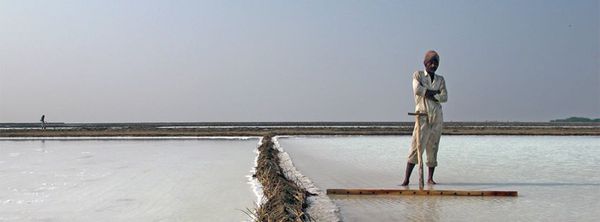Eye For Film >> Movies >> My Name Is Salt (2013) Film Review
My Name Is Salt
Reviewed by: Rebecca Naughten

Opening with an epigraph from Albert Camus' The Myth of Sisyphus (“The struggle towards the heights is enough to fill a man’s heart”), Farida Pacha's feature debut presents the stark beauty of the salt marshes of Gujarat in India as a counterweight to the arduous and methodical work of those who harvest that land. The salt families' Sisyphean task is to spend eight months of the year cultivating and harvesting the whitest salt crystals in the world, only for the annual monsoon season to wash everything away, turning desert into sea - when the waters subside, the families return to begin again.
The film follows one family through those eight months, beginning with their return and a sequence that shows them physically rebuilding their lives on the marshes - houses are constructed from materials arriving on the same truck as the family, their tools will be handmade to the specifications of the tasks required, and the more motorised equipment (namely the pump used to extract water from far beneath the surface) is - amazingly - dug out of the earth itself. The heavy, oil-fuelled pump is evidently too difficult to move on an annual basis, so rather ingeniously a deep pit is dug into the sticky clay beneath the dusty crust and the heavy duty equipment is buried and resurrected after the monsoon season. From a desolate, cracked desert surface, the farm seems to spring from the earth itself, such is the economy and ingenuity with which it is created - and form always follows function.

In the absence of a narration, and little in the way of extended conversation between the family members, the observed sounds and rhythms of their painstakingly-precise labour become the main dialogue of the film. This starts with the put-put noise of the motorised pump, which is never switched off and becomes a constant presence throughout the family's stay - when it breaks down at a crucial stage of the harvest, the resulting silence amplifies the tension of the situation.
But most of the family's work is done by hand - or, more precisely, by foot. The rhythmic manner in which a line of family members slowly shuffle across a salt pan, treading down the sodden surface so as to pack the crystals tighter together, builds into a hypnotic sound resembling a percussive musical accompaniment - while the slow, repetitive movement develops into a kind of dance. These rhythms are also echoed in the domestic spaces, whether slapping clay onto the ground to create a smooth floor, or the patting of chapattis as dinner is being cooked.
After expansion comes retraction - the farm withdraws back into the earth as the monsoon season approaches. The harvest is collected (piles of salt in long rows, which the director frames as a mirror image to the cloud formations overhead) and the family race against time - and increasingly tumultuous weather - to pack everything up and bury their equipment once more before the rain arrives. The remains of their diligently-observed processes are left as scars on the surface of the land, but these quickly disappear as the rain comes and the sea rises once more.
This is not a social commentary-type of documentary - the pittance the salt families are paid for their backbreaking labour and the power held by the salt traders is only briefly touched upon - but a lyrical celebration of human endeavour in challenging circumstances.
Reviewed on: 23 Jun 2014















